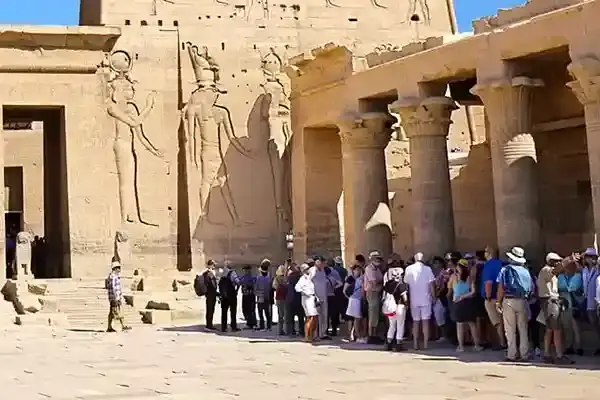The name of Nile comes from the Greek "Neilos," which is linked to the Semitic root "naḥal," which means valley. The river's northward flow and seasonal floods intrigued ancient Egyptians and Greeks. What are your thoughts on the fascinating 5 facts about Nile river? Have you discovered the fascinating facts and mysteries of the Nile River? Are you envisioning the magic of a nighttime journey on its waters and enjoying the whispers of history?
Table of contents [Show]
How old is the river Nile?
The Nile is 4,130 miles (6,650 kilometers) long and flows through northeastern Africa. Some scientists believe it has been in its current pathway for at least 6 million years, while others suggest it could be much older. A recent study in Nature Geoscience presents evidence that the Nile may be at least 30 million years old.
About 30 million years ago, the early Nile was a shorter stream originating between 18° and 20° N latitude, likely fed by the present-day Atbara River. To the south, the enclosed drainage system of Lake Sudd was located.
Around 25,000 years ago, the East African drainage to Lake Victoria developed a northern outlet into Lake Sudd. Sediments gradually raised the lake's water level, leading to an overflow that drained the lake to the north. The overflow made a riverbed connecting Lake Victoria and the Mediterranean Sea via the Nile system.
Are you ready for our 8-day Cairo, Luxor, and Aswan Classic Tours ? Discover the incredible experiences that await you!
The Source of the Nile River

The search for the source of the Nile River was a major scientific pursuit in 19th-century Europe. Before Google Maps, this quest was as thrilling as the race to the moon and marked by heroism and intrigue.
Christopher Ondaatje, an explorer and author of *Journey to the Source of the Nile*, states, “The mystery of the source of the Nile has been a challenge for three millennia.” Despite various claims of discovery over the years, modern experts agree that the true source of the Nile River remains uncertain.
It is now widely accepted that the Nile River has two primary sources: the Blue Nile and the White Nile. They meet in Khartoum, Sudan, before flowing into Egypt. The Blue Nile begins at Lake Tana in Ethiopia, and the White Nile starts from the Lake Victoria region, exiting at Jinja, Uganda.
How long is the Nile river
The Nile River is measuring about 4,132 miles (6,650 kilometers). While it is traditionally recognized as the longest, some believe the Amazon River might be longer. The United States Geological Survey estimates that the Nile River is approximately 100 miles longer than the Amazon River.
It flows north from its source in the Kagera River in Burundi to the Mediterranean Sea. The Nile Basin spans around 1,293,000 square miles (3,349,000 square kilometers), roughly 10% of Africa’s land area, encompassing parts of Tanzania, Burundi, Rwanda, the Democratic Republic of the Congo, Kenya, Uganda, South Sudan, Ethiopia, Sudan, and Egypt. There are three main tributaries: the Atbara, Blue Nile, and White Nile, that nourish the river.
Enjoy a 10-day Cairo, Aswan, Luxor & Hurghada Overland Tour . Explore iconic sites, cruise the Nile, and relax on Hurghada's beaches. Experience Egypt’s history and culture in one trip.
How deep is the Nile River?

The Nile River has a depth of 26 to 36 feet and measures approximately 4,130 to 4,190 miles long, making it one of the longest rivers in the world. It flows into the Mediterranean Sea and discharges over three million liters of water every second.
The depth of the Nile River varies throughout its course, from shallow stretches to deeper areas near the meeting point of the Blue Nile and White Nile, where it can reach significant depths. depths of several tens of meters. Factors such as the river's width, flow rate, and geological features affect these measurements.
The Arabs created the Nilometer to measure the river's depth, which aided in predicting floods and droughts. Overall, the river's depth can change significantly due to geography, seasons, and human activities.
The deepest point of the Nile River reaches 1,600 meters, while its widest stretch extends to about 160 kilometers.
Don’t miss your chance: 4 Night Luxury Nile Cruise Oberoi Philae from Aswan
Read about: Does It Snow in Egypt
5 facts about Nile River
The Nile River in Egypt isn’t only the longest river path through Africa but also shapes life in Egypt. It is more significant for people and wildlife living nearby than other rivers. The Nile River has an importance that differs from other rivers, as the great ancient Egyptian civilization established on it.
5 facts about Nile River:
1. The Nile is the main reason for defining the identity of Egypt. As it enters Egypt, the Nile creates a green oasis in the Sahara, transforming the landscape through seasonal floods that support agriculture and shape human history.
2. The source of the Nile remained a mystery for centuries. Ancient explorers struggled to locate it, often hindered by the Sudd swamp in South Sudan. The Blue Nile was traced back to Ethiopia, while the source of the White Nile remains debated, with some suggesting it begins with the Kagera River from Burundi.
3. The Nile River is fed by three main tributaries: the White Nile, the Blue Nile, and the Atbara River. The White Nile starts at Lake Victoria and flows northward to join the Blue Nile at Khartoum, Sudan. It has a steady flow year-round, while the Blue Nile contributes mostly in summer, providing nearly 60% of the water that reaches Egypt.
4. The Nile takes a surprising detour in the Sahara, flowing southwest for about 300 km (186 miles) before coming back north. This curve, called the "Great Bend," is due to the Nubian Swell, a geological uplift that altered its path.
5. The Nile River in Egypt is still a source of transportation till now. It means that your tour through it will be an amazing experience, enjoying the breathtaking nature.
Egypt Luxury Tours : Experience an amazing ancient history, rich culture, and stunning landscapes all in one trip.
Nile River Facts For Kids
Egypt the Gift of the Nile River.
Although the Nile River is most commonly associated with Egypt, it traverses 11 countries: Tanzania, Uganda, the Democratic Republic of the Congo, Rwanda, Burundi, Ethiopia, Kenya, Eritrea, South Sudan, Sudan, and Egypt.
Historically, the Nile has been crucial for survival. About 5,000 years ago, the Ancient Egyptians depended on it for fresh water, food, transportation, and farming.
The Nile flooded every August, spreading nutrient-rich soil across the riverbanks, which made farming possible in the desert.
In addition to its importance for humans, the Nile supports a variety of wildlife, including fish, birds, turtles, snakes, hippos, and Nile crocodiles.
The Nile is home to various fish species, including Nile perch, catfish, eels, lungfish, mudfish, and tigerfish. Nile perch can weigh as much as 300 pounds (140 kilograms). The Nile is home to a variety of reptiles, including the Nile crocodile, soft-shelled turtles, and numerous snake species.
To celebrate this vital river:
Egyptians hold a two-week holiday called ‘Wafaa an-Nil’ every August, honoring the annual flooding that sustained their civilization.
Recognize all Egypt tour packages and all-inclusive vacations to Egypt now for a transformative experience!
Maybe like: What Is There to Do in Luxor
Amazing question: Why the Nile River Was So Important to Ancient Egypt?

Egypt the Gift of the Nile River
Egypt is a remarkable gift from the Nile, as this vital river has been the foundation of its civilization. By providing essential water and fertile silt in the desert, the Nile enabled the region to thrive and flourish.
The Nile served as the primary transportation route due to scarce roads, with boats facilitating the movement of people and goods.
The Nile River was both beneficial and unpredictable. Low rainfall led to famines while flooding destroyed villages.
Each year, Nile floods bring nutrient-rich silt that enriches the soil, allowing for high agricultural yields and supporting a large population, with wheat becoming a key currency.
The Nilometer measures the river's water level to predict crop yields and determine taxes. High levels result in abundant crops and higher taxes, while low levels mean lower taxes. The Egyptians also used papyrus from the Nile to create paper for writing. If you want to see more, book your Grand Egyptian Museum Tour .
Around 5,000 years ago, tribes united to manage these issues, forming kingdoms and eventually unifying Egypt.
What about spending 12 Days in Luxury Cairo, The Nile & Red Sea
And take a look at : How many days in Luxor
FQA
1-Why is the Nile River famous?
The Nile River is famous for its fertile soil, which supports agriculture, and for serving as a key transportation route for goods between cities in ancient Egypt. It was important for food and trade.
2-Why is Egypt often called the "Gift of the Nile?
Egypt is often referred to as a gift from the Nile because the river was crucial for its civilization, providing essential water and fertile silt in the surrounding desert. It provides the water needed for crops, enabling civilizations to thrive.
3-What did Egyptians call the Nile?
Ancient Egyptians referred to the Nile as Ḥꜥpy (Hapy) or Jtrw (Iteru), meaning "river". In Coptic, it was called ⲫⲓⲁⲣⲟ (piaro or phiaro), which also means "the river."
4-Why were Pyramids built?
Pyramids were constructed as burial sites for pharaohs, reflecting the ancient Egyptians' beliefs in an afterlife. They symbolize the beginning of the journey to eternity.
Popular Categories
Popular Posts

Top Alexandria Beaches You Must Visit 2026

What are the important holidays in Egypt?









